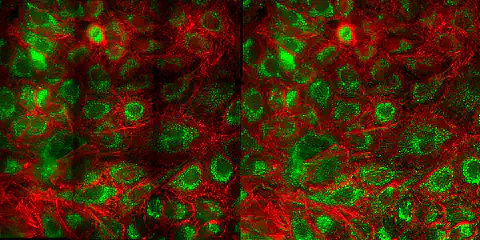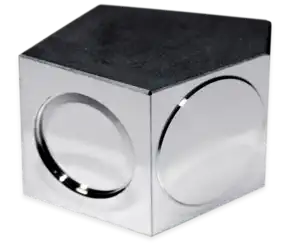
Story 13: Making the world a better place with aspheres – Do you know where aspheres are used?
It wasn’t long ago that aspherical optics had a reputation for being rather tricky. Tolerancing was complicated, and they were also hard to manufacture. But in recent years, the image of aspherics has been transformed. Thanks to their high utility value, leading technology fields such as science, metrology and laser applications would now be inconceivable without aspheres. We at asphericon are proud to have played a major part in the success of the aspherical lens and to have shaped its development over the last 20 years.

Stitched rimless images produced in the experiment at CREOL using a conventional system (Gaussian beam) on the left and an a|TopShape on the right (source: CREOL)
Did you know that the use of our a|BeamExpander and our a|TopShape leads to improved imaging in microscopy – and thus simplifies the diagnosis of neurodegenerative diseases? When integrated into a microscope, these compact, highly precise optical components can provide a uniformly illuminated rimless image. In a demonstration project, scientists at CREOL (the University of Central Florida College of Optics and Photonics) used optics from asphericon to minimize the previous limitations of TIR fluorescence microscopy and hence improve the standard of imaging.

Weld seam created using conventional system (top) & a|AiryShape (bottom) (source: ifw Jena)
Another area where aspheres are making a crucial difference is the additive manufacturing of complex components, now a widespread process in the manufacturing industry. Additive manufacturing enables fully functional three-dimensional components with the highest material standards to be produced in all shapes and sizes. However, time is a limiting factor in additive manufacturing, and producing large components often takes several hours.
In addition, the Günther Köhler Institute for Joining Technology and Materials Testing (ifw Jena) now uses our a|BeamExpander and our a|AiryShape to enhance laser beam welding. By using these two products, spatter formation is reduced and high-quality welds without any edge or root notches can be achieved, saving both time and money.
Did you know that asphericon was also involved in research for the ITER International Thermonuclear Experimental Reactor? ITER is expected to pave the way for the generation of huge amounts of safe, green energy. The team of researchers working on the ASDEX Upgrade experimental facility at the Max Planck Institute for Plasma Physics in Germany is developing the basic principles for the planning and operation of the ITER demonstration reactor. To measure the temperature and density of electrons near the edge of the plasma, they’re using a light detection system in which two optics supplied by asphericon have been fitted. These two lenses are used to capture light, which is then examined by means of spectrometric analysis. Our aspherical optics enable superior imaging quality as well as measurement with high spatial and temporal resolution. Even though this is only a small component of this international research project, we’re very proud!

Germanium monolith (= freeform optic) manufactured by asphericon
In addition to aspheres, freeform opens up new potential for future technologies, such as life science, automation solutions, laser material processing and sensors. The use of freeform optics enables highly complex items to be reduced in size, since space and weight can be saved without having to sacrifice excellent imaging quality. What’s more, asphericon’s freeforms are resistant to environmental influences such as extreme heat, cold and pollution, and also perform new functions that traditional optics can’t. Since 2014, we’ve been collaborating with other partners in the regional growth core ƒo+, which stands for ‘freeform optics plus’. We realize that cutting-edge systems require new standards in optics – and are actively involved in helping to set them. For example, we’ve teamed up with other research partners to develop an optical freeform system for a driving assistance system that takes up 75% less space, yet still has unprecedented imaging properties. Installed in a thermographic sensor, our technology helps to increase the safety of autonomous vehicles.
Our products are used in almost every industry relying on high-quality optics. We’re excited about the challenges ahead – and look forward to using our expertise to keep shaping optical solutions.